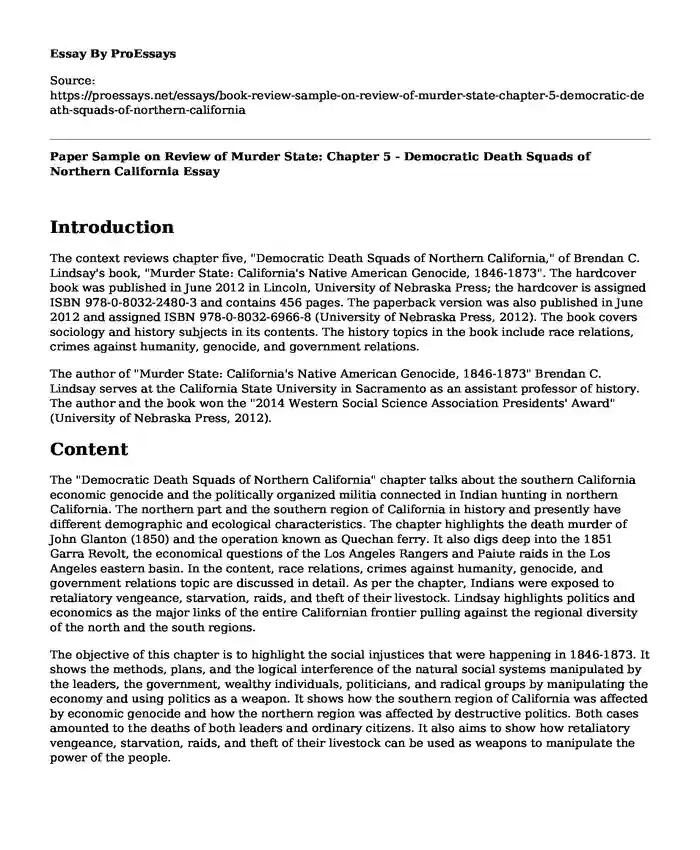Introduction
The context reviews chapter five, "Democratic Death Squads of Northern California," of Brendan C. Lindsay's book, "Murder State: California's Native American Genocide, 1846-1873". The hardcover book was published in June 2012 in Lincoln, University of Nebraska Press; the hardcover is assigned ISBN 978-0-8032-2480-3 and contains 456 pages. The paperback version was also published in June 2012 and assigned ISBN 978-0-8032-6966-8 (University of Nebraska Press, 2012). The book covers sociology and history subjects in its contents. The history topics in the book include race relations, crimes against humanity, genocide, and government relations.
The author of "Murder State: California's Native American Genocide, 1846-1873" Brendan C. Lindsay serves at the California State University in Sacramento as an assistant professor of history. The author and the book won the "2014 Western Social Science Association Presidents' Award" (University of Nebraska Press, 2012).
Content
The "Democratic Death Squads of Northern California" chapter talks about the southern California economic genocide and the politically organized militia connected in Indian hunting in northern California. The northern part and the southern region of California in history and presently have different demographic and ecological characteristics. The chapter highlights the death murder of John Glanton (1850) and the operation known as Quechan ferry. It also digs deep into the 1851 Garra Revolt, the economical questions of the Los Angeles Rangers and Paiute raids in the Los Angeles eastern basin. In the content, race relations, crimes against humanity, genocide, and government relations topic are discussed in detail. As per the chapter, Indians were exposed to retaliatory vengeance, starvation, raids, and theft of their livestock. Lindsay highlights politics and economics as the major links of the entire Californian frontier pulling against the regional diversity of the north and the south regions.
The objective of this chapter is to highlight the social injustices that were happening in 1846-1873. It shows the methods, plans, and the logical interference of the natural social systems manipulated by the leaders, the government, wealthy individuals, politicians, and radical groups by manipulating the economy and using politics as a weapon. It shows how the southern region of California was affected by economic genocide and how the northern region was affected by destructive politics. Both cases amounted to the deaths of both leaders and ordinary citizens. It also aims to show how retaliatory vengeance, starvation, raids, and theft of their livestock can be used as weapons to manipulate the power of the people.
Methods of Writing
The method of writing used is expository and descriptive; it is descriptive because it describes the historical events as they occurred by referring to documented sources of that time without presenting a personal opinion. It also holds an expository trait because it exposes the actual occurrence of events while referring to documented evidence by a government official, other leaders, politicians, influential individuals, and army officer who operated in that historical time.
Lindsay managed to achieve the goal of explaining how race relations, crimes against humanity, genocide, and government relations amounted to deaths. For example, Lindsay explains how the Indians started burning houses of their enemies, the Tehama County people after the Tehama residents attacked them and killed women and children (Lindsay, 2012, p. 198). The war was instigated by the leaders and funded by the government. Lindsay is not objective as he used historical evidence to present the arguments and facts. For instance, Lindsay uses quoted reports from some other army officer admitting the commencement of the war and the exact occurrences that happened (Lindsay, 2012, p. 198). The government official, other leaders, politicians, influential individuals, and army officers documented the happenings from which Lindsay got the facts. The documented events were relevant to present the topic in the chapter.
Conclusion
I would recommend this chapter because it does not only connect the social, economic, and political view of California's Native American Genocide but also reveals excerpts of evidence recorded in that historical time to support in claims.
Works Cited
Lindsay, Brendan C. Murder State : California's Native American Genocide 1846-1873. Univ Of Nebraska Press, 2012.
University of Nebraska Press. "Murder State California's Native American Genocide, 1846-1873." Unl.Edu, 2012, www.nebraskapress.unl.edu/university-of-nebraska-press/9780803224803/.
Cite this page
Paper Sample on Review of Murder State: Chapter 5 - Democratic Death Squads of Northern California. (2023, Sep 25). Retrieved from https://proessays.net/essays/book-review-sample-on-review-of-murder-state-chapter-5-democratic-death-squads-of-northern-california
If you are the original author of this essay and no longer wish to have it published on the ProEssays website, please click below to request its removal:
- Research Proposal Sample: Relationship Between Migration and Unemployment Among Migrant in Sweden
- Essay Example on Self-reflection Ethics
- The United States Counterintelligence - Essay Sample
- "White People" Video Analysis Paper Example
- Essay Sample on The Constitution: Executive Powers & Roles
- Essay Example on Hong Kong-China Divide: Clash of Legal Systems
- Essay Sample on Ethical Principles: Defining Right and Wrong







